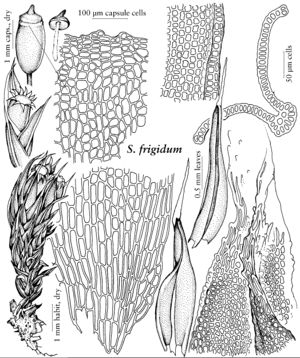Schistidium frigidum
Bryophyt. Biblioth. 49: 181, fig. 70. 1996,.
Plants in open, occasionally flattish tufts or cushions, olivaceous, often in part yellow-green, rarely blackish. Stems 1–2 (–4) cm, central strand distinct or absent. Leaves erect or slightly curved, usually imbricate when dry, narrowly ovatelanceolate to ovatelanceolate, sharply keeled distally, 1.1–2.1 mm, 1-stratose, rarely with 2-stratose striae distally; margins recurved to just before the apex, often denticulate distally, 1-stratose or 2-stratose; apices acute or somewhat obtuse; costa excurrent as a coarsely denticulate, often slightly flexuose, usually decurrent awn, rarely percurrent (in alpine habitats), smooth; some basal-cells sometimes much lighter than adjacent cells, often hyaline, sometimes with yellowish walls, marginal cells quadrate or elongate-rectangular, often strongly trigonous or with more thickened transverse walls; distal cells often of various shapes, short-rectangular or isodiametric, sometimes ovate or subtriangular, 6–10 µm wide, usually strongly sinuose. Sexual condition autoicous. Capsule redbrown, sometimes orangebrown, cylindric, 0.7–1.1 mm; exothecial cells irregularly shaped, isodiametric or oblate, thin-walled or slightly thickened, trigonous; stomata present; peristome patent to squarrose, sometimes revolute, 230–300 µm, orange-red or yellowish red, densely to finely papillose, weakly perforated. Spores 10–14 µm, granulose or nearly smooth.
Phenology: Capsules mature late spring to early summer.
Habitat: Rock in open to shaded habitats
Elevation: moderate to high elevations (500-3300 m)
Distribution

Greenland, Alta., B.C., Nfld. and Labr. (Nfld.), N.W.T., Nunavut, Ont., Que., Yukon, Alaska, Colo., Idaho, Mich., Mont., Nev., N.Mex., Oreg., Wash., Wyo., Eurasia
Discussion
Schistidium frigidum is rather common yet is one of the more difficult taxa to determine with confidence, as the examination of many leaves is often necessary before the elongate basal marginal cells are obvious. Often, some central basal cells are much lighter than adjacent cells, and are often hyaline, and form contrasting patches, which helps to identify the species. In contrast to S. dupretii and S. confertum, which have a large proportion of elongate exothecial cells, S. frigidum has exothecial cells that are mainly isodiametric or oblate.
Selected References
None.
Lower Taxa
"um" is not declared as a valid unit of measurement for this property.
